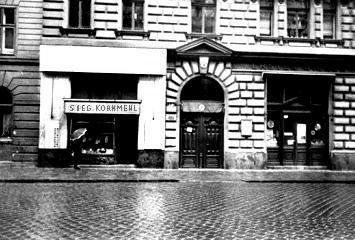
This much I know: For more than four decades, Sigmund Freud and my great uncle, Siegmund Kornmehl, rented space in the same building in Vienna, 19 Berggasse. Siegmund Kornmehl had a storefront butcher business, while Sigmund Freud lived and practiced psychoanalysis upstairs.
Beyond that, things get fuzzier.
Was Martha Freud Really Affronted?
I haven’t yet found records to confirm exactly when my great uncle opened his butcher shop in the building, which was new in September 1891, when Freud moved in, but I got a working hypothesis from Mrs. Freud: A Novel by Nicolle Rosen. Although her feminist-oriented account of Martha Bernays’ marriage to Sigmund Freud is fictional, the author cites a long list of biographical resources to back up her story, including letters and journals.
The fictional Mrs. Freud writes (emphasis mine):
I liked our first home in Vienna, an affordable apartment in a nice looking modern building near the Ring…. Bergasse was not too far from the Ring, but the area was considerably less elegant than our former neighborhood….Our move had the advantage of keeping us in the vicinity of the Freud family, which was important since we frequently traded visits. Still, I remember being disappointed the first time I saw the place, finding the new construction rather ordinary. What irked me especially was the butcher shop, which stood right next to our entrance. And to add insult to injury, the butcher’s sign, which was cheek-by-jowl with my husband’s, also bore the name Sigmund! Unbelievable as it may be, the butcher and Sigmund shared the same first name! We had to grin and bear it. But as with everything in life, we finally got used to it. Just as well, because we went on living at that address for nearly 47 years.
Again with the butcher snobbery! Apparently Rosen didn’t know that butchers were powerful in Vienna during that era — perhaps having a greater effect on local politics than the somewhat suspect, sex-obsessed Dr. Freud.

I have tried to locate Nicolle Rosen to track down the source of this observation, so far with no success, and have found no other proof that Siegmund Kornmehl moved into the building before Sigmund Freud did.* In any event, the notion that the signs were “cheek-by-jowl” seems inaccurate, unless Rosen is referring to the lobby directory, where “Freud” might have been followed alphabetically by “Kornmehl” — if, that is, Rudolph Hauser, who lived in apartment number 8 according to the catalog to the Freud Museum exhibit “Freud’s Lost Neighbors,” had not yet moved in.
Of course, the large sign on the butcher shop might have been added later, but I still don’t see how a storefront sign could compete with that of physician whose offices were inside the building. If you look at the picture to the left, no other signs than those on the butcher shop are evident in front.
No Claim to the Name
But the question of the dueling Si(e)gumund signs is really moot. Neither the butcher nor the doctor were born with the name, although Freud no doubt adopted it first.
Dr. Freud was born Sigismund Schlomo Freud in the town of Freiberg (today’s Pribor) in Moravia (now in the Czech Republic) on May 6, 1856.
And according to his marriage records, Moises Schulim (called Siegmund) Kornmehl was born September 16, 1868 in Radlow, Poland,
The Behind the Name site says that Sigmund is derived from the Germanic elements sigu “victory” and mund “protector” and cites Siegmund and Sigismund as variants.
According to several sources, Sigismund Freud “simplified” his first name to Sigmund when he was 21, in 1877.
I don’t know when Moises Kornmehl became Siegmund but likely not before 1877, since he would have only been 9 years old. I also don’t know why he chose to include an “e” and Freud didn’t. Maybe he was fan of the composer, Richard Wagner, and named himself after Siegmund, a focal character the Die Walküre (the Valkyrie), the second of four operas in the Ring cycle, which debuted in 1870. Then again, Wagner wasn’t known for his love of Jews.
It might be more reasonable to surmise that both men from the boonies decided that a more sophisticated — not to mention manly — German name was appropriate for life in the big city, Vienna.
*UPDATE: An affidavit I found dated October1938 and referring to the Aryanization of the property indicate that Siegmund Kornmehl moved into the building in 1895, four years after the Freud family. Rosen’s notion that Martha Freud was appalled by the butcher with the same name was thus a complete fabrication.

I have a personal interest in the wives of historical male figures and Rosen’s novel interests me, even if it is a work of fiction. I’d be curious to learn her sources as well and hopefully if you are able to track down the author, you will let us know.
I was actually a little disappointed, Kristine, because I was hoping for more domestic details of Freud’s life and really didn’t get them. You might be interested in the book anyway, however — and she does list a lot of lot of sources, just not specific ones for this particular detail that I could find.
Also… I should have mentioned that the original is in French, which is one of the reasons I had a problem finding the author. Maybe some things were lost in translation….
Thanks for coming by.
Or it could have been Three Siggies by Edie Anton Chekhov Jarolim.
Good one! Hmmm…. I see a contest coming on…